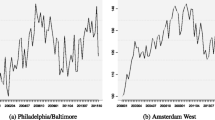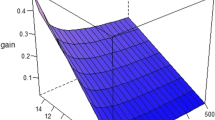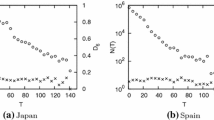Abstract
Since real estate is heterogeneous and not all its quality attributes are observable, the repeat sales model pioneered by Bailey et al. (1963) has become one of the standard methods to estimate a constant-quality price index. The model, however, fails to adjust for depreciation, as age and time between sales have an exact linear relationship. This paper proposes a new method to estimate an age-adjusted repeat sales index by decomposing property value into land and structure components. As depreciation is more relevant to the structure than land, the property’s depreciation rate should depend on the relative size of land and structure. The larger the land component, the lower the depreciation rate of the property. This new method is applied to property transactions in Hong Kong and Tokyo. Hong Kong is shown to have a higher depreciation rate based on a fixed structure-to-property value ratio, while the resulting age adjustment is larger in Tokyo because its land value has shrunken over time.





Similar content being viewed by others
Notes
Instead of using time dummies, another way is to estimate and predict, through period-by-period hedonic regressions, the value of a reference property over time.
Diewert et al. (2015) proposed a new hedonic model, with construction cost as the additional information, to decompose prices into land and structure components.
In general, the inelastic supply of land makes land value more volatile and more sensitive to economic shocks than building value.
Box-Cox transformation requires that the age variable is strictly positive.
If the error term is suspected to be heteroscedastic, one can apply Case and Shiller’s (1989) Weighted Repeated Sales (WRS) method that allows drift in individual property value through time.
Recruit Co., Ltd. provided us with information on contract prices for about 24% of all listings. Using this information, we were able to confirm that prices in the final week were almost always identical to the contract prices; see Shimizu et al. (2012).
The downward bias in the δ estimate reinforces our prediction that the true δ should be positive.
Shimizu et al. (2010) has described the property attributes used for hedonic estimation, which are not repeated here.
For the hybrid model, Box-Cox transformation has not been applied to the age term and so the depreciation rate is constant (−1.51%).
References
Bailey, M. J., Muth, R. F., & Nourse, H. O. (1963). A regression model for real estate price index construction. Journal of the American Statistical Association, 58, 933–942.
Cannaday, R. E., Munneke, H. J., & Yang, T. T. (2005). A multivariate repeat-sales model for estimating house price indices. Journal of Urban Economics, 57, 320–342.
Case, B., & Quigley, J. M. (1991). The dynamics of real estate prices. Review of Economics and Statistics, 22, 50–58.
Case, K. E., & Shiller, R. J. (1989). The efficiency of the market for single-family homes. American Economic Review, 79(1), 125–137.
Chau, K. W., Wong, S. K., & Yiu, C. Y. (2005a). Adjusting for non-linear age effects in the repeat sales index. Journal of Real Estate Finance and Economics, 31(2), 137–153.
Chau, K. W., Wong, S. K., & Yiu, C. Y. (2005b). Real estate price indices in Hong Kong. Journal of Real Estate Literature, 13(3), 337–356.
Clapp, J. M., & Giaccotto, C. (1998). Residential hedonic models: A rational expectations approach to age effects. Journal of Urban Economics, 44, 415–437.
Diewert, W. E., de Haan, J., & Hendriks, R. (2015). Hedonic regressions and the decomposition of a house price index into land and structure components. Econometric Reviews, 34(1–2), 106–126.
Englund, P., Quigley, J. M., & Redfearn, C. L. (1998). Improved price indexes for real estate: Measuring the course of Swedish housing prices. Journal of Urban Economics, 44, 171–196.
Gatzlaff, D. H., & Haurin, D. R. (1997). Sample selection bias and repeat-sales index estimates. Journal of Real Estate Finance and Economics, 14(1), 33–50.
Hill, R. C., Knight, J. R., & Sirmans, C. F. (1997). Estimating capital asset price indexes. Review of Economics and Statistics, 79(2), 226–233.
Itabashi, M., & Fukuda, H. (1999). The Japanese building standard law and a series of steels for earthquake-resistant building structures. Technology, Law and Insurance, 4, 37–44.
Karato, K., Movshuk, O., & Shimizu, C. (2010). Semiparametric estimation of time, age and cohort effects in a hedonic model of house prices. Working paper no. 25, Faculty of Economics, University of Toyama.
Lai, J. H. K., Yik, F. W. H., & Jones, P. (2004). Disputes arising from vaguely defined contractual responsibilities in building services maintenance contracts. Facilities, 22(1–2), 44–52.
Palmquist, R. B. (1980). Alternative techniques for developing real estate price indexes. Review of Economics and Statistics, 66, 394–404.
Rosen, S. (1974). Hedonic prices and implicit markets: Product differentiation in pure competition. Journal of Political Economy, 82(1), 34–55.
Shimizu, C., Nishimura, K. G., & Watanabe, T. (2010). House prices in Tokyo - a comparison of repeat-sales and hedonic measures. Journal of Economics and Statistics, 230(6), 792–813.
Shimizu, C., Nishimura, K. G., & Watanabe, T. (2012). House prices from magazines, realtors, and the land registry: Property market and financial stability. BIS papers no. 64. Bank of International Settlements, March, 2012, 29–38.
Wong, S. K., Cheung, A. K. C., Yau, Y., Ho, D. C. W., & Chau, K. W. (2006). Are our residential buildings healthy and safe? A survey in Hong Kong. Structural Survey, 24(1), 77–86.
Author information
Authors and Affiliations
Corresponding author
Rights and permissions
About this article
Cite this article
Wong, S.K., Chau, K.W., Karato, K. et al. Separating the Age Effect from a Repeat Sales Index: Land and Structure Decomposition. J Real Estate Finan Econ 57, 351–366 (2018). https://doi.org/10.1007/s11146-017-9631-2
Published:
Issue Date:
DOI: https://doi.org/10.1007/s11146-017-9631-2




